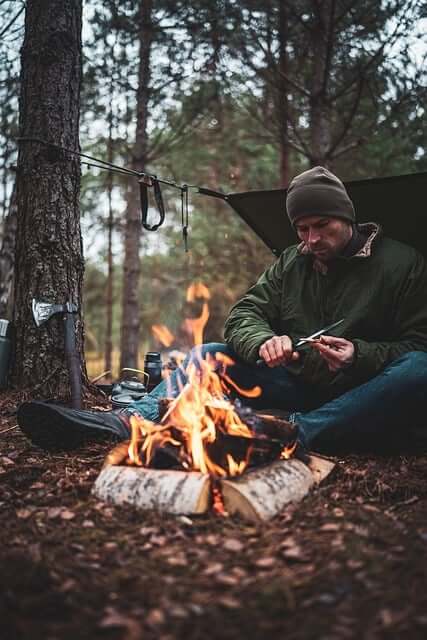Bushcraft & Wilderness Tools

Introduction to Bushcraft & Wilderness Tools
When it comes to bushcraft and wilderness survival, having the right tools is essential for thriving in nature. These tools allow you to handle everything from building shelters to starting fires and foraging for food. Here’s a breakdown of the most critical items for bushcraft:
- Fixed-Blade Knife: Versatile for cutting, carving, and preparing food.
- Fire Starter Kit: Essential for creating fire in all conditions.
- Axe or Hatchet: Useful for chopping wood and building shelters.
- Water Filtration System: Ensures access to clean drinking water.
- Multi-Tool: Provides multiple functions in one compact tool.
- Shelter Materials: Includes tarps, cordage, or emergency blankets.
These tools equip you for various wilderness survival tasks, allowing you to rely on your skills and environment.
How important are the brands when it comes to Bushcraft Tools? Or where they're made?
When selecting bushcraft tools, brand reputation and manufacturing location can play a significant role in quality and reliability. Here’s what to consider:
- Brand Reputation: Established brands like Morakniv, Gerber, and Hultafors are trusted for their durability and performance.
- Price vs. Quality: Higher-end brands often use premium materials, while budget options might sacrifice some durability.
- Manufacturing Location: Tools made in regions known for craftsmanship, like Scandinavia, often offer superior quality.
- User Reviews: Always check reviews for real-world performance insights.
Choose tools based on the demands of your bushcraft activities and their reliability.
How should I maintenance my Bushcraft/Wilderness Tools?
Maintaining your bushcraft and wilderness tools is crucial to ensuring their longevity and functionality in the field. Here are some general maintenance tips:
- Clean After Use: Always wipe down tools after each use to remove dirt, moisture, or plant residue.
- Sharpen Blades Regularly: Keep knives, axes, and machetes sharp with proper sharpening stones or honing tools.
- Oil Metal Parts: Prevent rust by oiling blades and metal surfaces using mineral oil or specialized tool oil.
- Inspect Handles: Wooden handles should be checked for cracks and oiled to prevent drying or splitting.
- Store Properly: Store tools in a dry, cool place, and use protective sheaths to avoid accidental damage.
Can I make money in Bushcraft/Wilderness Tools?
Yes, making money with bushcraft and wilderness tools is possible through various avenues:
- Selling Gear: Retailing or creating custom tools such as knives, axes, or fire-starting kits.
- Courses and Workshops: Offering training in survival skills and bushcraft techniques.
- Content Creation: Running blogs, YouTube channels, or social media accounts that review gear or teach bushcraft techniques, with potential income from sponsorships or ads.
- Guided Expeditions: Leading wilderness adventures focused on bushcraft skills can generate revenue while leveraging your expertise with survival tools.
Is a starting general Bushcraft Toolkit expensive?
Starting a general bushcraft toolkit can range from moderate to more expensive depending on the quality and variety of tools. Here’s a quick summary of the costs:
- Fixed-blade Knife: $40 – $150
- Firestarter Kit: $10 – $50
- Folding Saw: $25 – $80
- Hatchet or Small Axe: $30 – $120
- Tarp or Shelter System: $20 – $100
- Paracord: $10 – $20
- Water Filtration System: $30 – $100
Total estimated range: $165 – $620, depending on brand and durability.
Essential Tools for Bushcraft and Wilderness Exploring
Bushcraft and wilderness exploration require a set of reliable, durable tools to ensure safety and efficiency in nature. Here are the essential tools:
- Fixed-Blade Knife: A sturdy knife for cutting, carving, and general utility tasks.
- Firestarter Kit: Ferro rods or flint for creating fire in any conditions.
- Folding Saw: Compact saw for cutting wood for shelters or fire.
- Hatchet or Small Axe: Useful for chopping wood and building shelter.
- Tarp or Bivvy: Lightweight, portable shelter protection.
- Water Filtration System: Ensures safe drinking water.
- Compass/Map: Essential for navigation.
- Paracord: For tying, building, and general utility.
- Multi-Tool: Compact and versatile for various small tasks.
- Cooking Kit: Lightweight pots or pans for preparing food.
These tools provide the foundation for surviving and thriving in wilderness environments.
Safety Bushcraft Tools? Or things that should be in the kit often forgotten...
Are there season-specific or altitude-specific tool considerations for Bushcraft?
Educational Resources for Bushcraft & Wilderness Toolkits
Here are some valuable educational resources to enhance your bushcraft and wilderness skills:
- Bushcraft USA – Offers a wealth of information on bushcraft techniques, tools, and survival strategies: Bushcraft USA
- Master Woodsman – A site that dives deep into wilderness living, traditional skills, and tool use: Master Woodsman
- Paul Kirtley’s Blog – Learn from one of the UK’s leading bushcraft instructors, covering essential tools and skills: Paul Kirtley’s Blog
- The Bushcraft Forum – A community offering discussions, advice, and resources on bushcraft gear and techniques: Bushcraft Forum
These resources provide knowledge on tool use, preparation, and practical skills for wilderness survival.
Are there Bushcraft communities or blogs that could be helpful?
Here are some helpful bushcraft communities and blogs to connect with like-minded individuals and gain valuable insights:
- Bushcraft UK – A well-known forum where members share tips on gear, skills, and survival techniques: Bushcraft UK
- Master Woodsman – A blog and community for those passionate about traditional skills and wilderness survival: Master Woodsman
- The Survival Podcast – Offers survivalist content with a focus on self-reliance, including bushcraft: The Survival Podcast
These communities provide valuable discussions and learning opportunities in bushcraft and wilderness survival.
Frequently Asked Questions (FAQ)
- What is bushcraft? Bushcraft refers to wilderness survival skills, such as building shelters, foraging for food, and crafting tools from natural resources.
- Is it expensive to get started in bushcraft? A basic toolkit can start relatively inexpensive, but higher-quality tools can increase the cost.
- What essential tools do I need for bushcraft? Key items include a survival knife, fire-starting tools, shelter equipment, and cooking gear.
- Are there safety tools to consider? Yes, including first aid kits, signal mirrors, and emergency whistles.
- Can you make money in bushcraft? Yes, through teaching, content creation, or selling bushcraft tools.
Ad Notice:
ToolFinder is a site as a free service. We do not charge a fee, and so we have ads on our site to help support development cost and basic time input.
We may also have links on our site to others for products - known as affiliate links - you will Not pay more by utilizing these links, but the merchant would provide ToolFinder a fee for the referral. As an Amazon Associate I earn from qualifying purchases.

